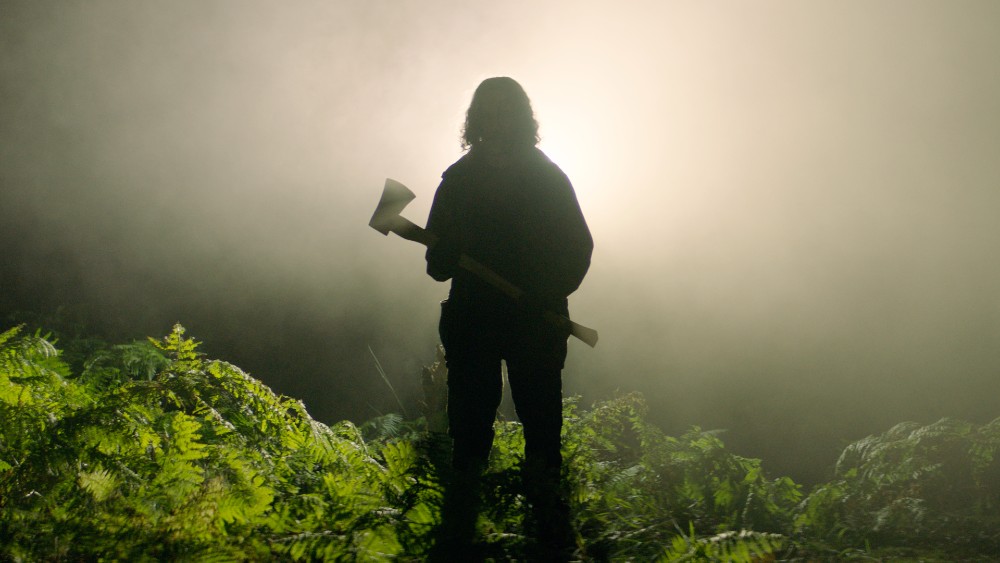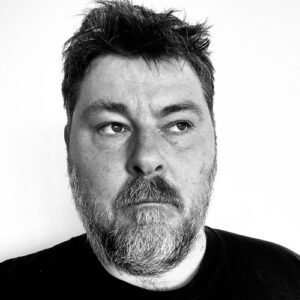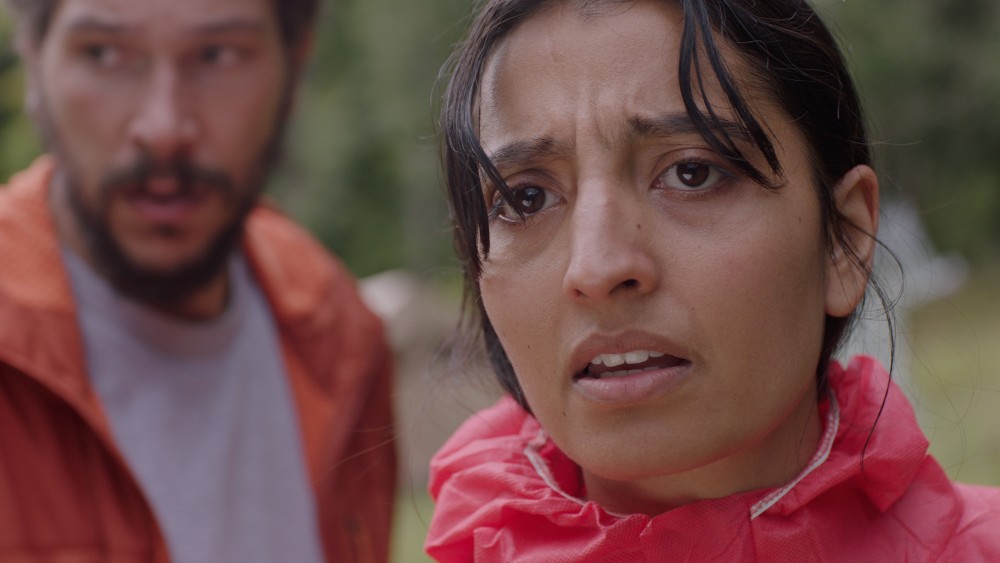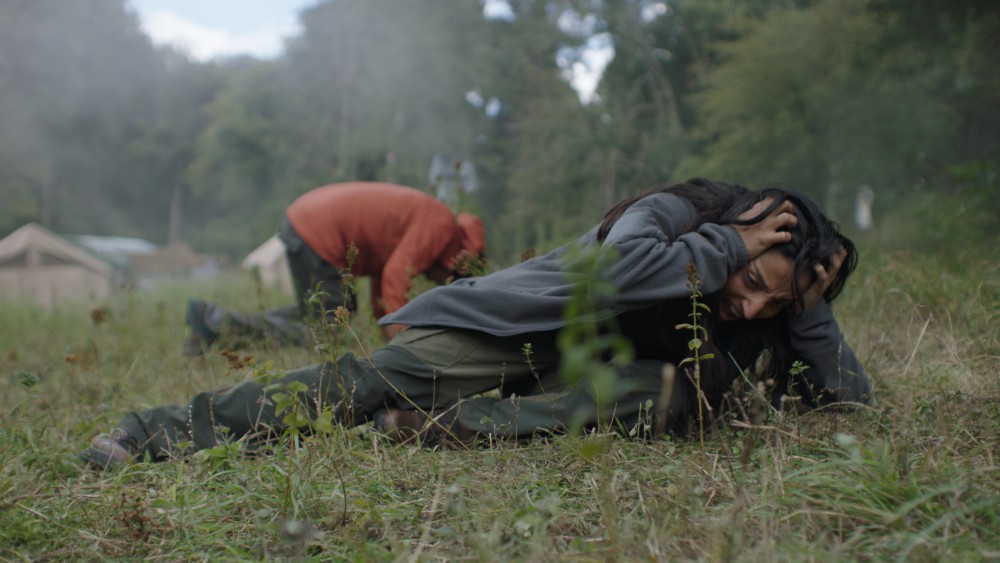
Director Ben Wheatley might be seen either as Britain’s most prolific indie filmmaker or possibly the most eccentric, depending on who you ask and whether they appreciate his frequent forays into the odder side of genre filmmaking.
His latest, In the Earth, begins with two rangers, played by Joel Fry and Ellora Torchia, venturing into the woods in search of missing scientists, but they soon come across an even stranger situation when they’re accosted and kidnapped by an eccentric woodsman named Zach (Reece Shearsmith). Where Wheatley’s latest film goes from there is quite horrifying and jarring yet it’s still far more cerebral than the usual horror film of this type — think: Wrong Turn or Texas Chainsaw Massacre but steeped in ecological lore and mythology.
More than anything, In the Earth not only shows off a number of great performances in a movie shot entirely last summer in the middle of a pandemic, but also some brilliant craftswork by DoP Nick Gillespie, Production Designer Felicity Hickson, Composer Clint Mansell, and Sound Designer Martin Pavey.
The following Below the Line interview was conducted over Zoom last week:

Below the Line: I know when you were out doing press for Rebecca last year, I think you were talking about doing another movie next, so had In the Earth already been gestating or was this more of a reaction to the pandemic?
Ben Wheatley: Yeah, I would have shot it already by that point, I think? Yes. When I was doing the press for Rebecca, it was already shot and done.
BTL: What kind of led you to write this? Was it something you had written before the pandemic hit or was it something influenced by the pandemic?
Wheatley: No, I started writing in the pandemic, so it’s not an old script. It’s brand-new and a reaction to the pandemic, basically.
BTL: It seems like you would have had to do a lot of research or were there elements that were things you had been interested in beforehand and found a way to put those elements into a movie?
Wheatley: I started reading about the Mycorrhiza and the forestry systems, and that was really intriguing. That was one element of it, and then another element was thinking about the narrative and about how humans spin stories around themselves, but the stories themselves are the only things that set humans apart from the rest of the animal kingdom. That’s our unique selling point thing, but then what happens when a human narrative is introduced to something that is completely alien, and how do these things interact? That was the kind of jumping off point really for it.
BTL: The fact that you shot it in the pandemic, what were some of your concerns going into it? I mean, a lot of it takes place in a forest with only one or two actors at a time, but I also assume it was fairly independent with not a ton of budget to do major COVID protocols.
Wheatley: Well, it was pragmatic. I mean, the transmission is very much reduced outdoors, so whatever the film was going to be, it was going to have to be outdoors. When you shoot indoors, you have to clean every surface all the time, and you’ve got crew packed into small spaces, and you’re going to get sick, basically. That was at the front of it, because we really wanted to make the movie, but at the same time, really didn’t want to get any of the crew ill. That was just at the front of my mind the whole time. So there were a lot of COVID protocols that we undertook, and kind of were very strict about the whole thing, and we were fine. We got through the whole thing, and no one got sick.
BTL: When were you shooting the movie last year?
Wheatley: In July.
BTL: I don’t think I ever realized that you edited your own movies, other than Rebecca, but you’ve been editing every movie you’ve made, pretty much, right?
Wheatley: Yeah, I’m a co-editor on most of the things. Colin Burstead had been a sole editing credit, but I started as an editor. So I’m always involved in it in a very granular way.

BTL: That makes sense. Does it make it easier when you’re shooting to know exactly what you’ll need later for the edit? Is that much more intuitive when you’re editing your own films, as much from editing as it is from directing?
Wheatley: Totally, man. It means you can be really confident about what you’re shooting and not shoot too much and not have to worry about coverage and all those things. You know when you hear the directors have a vision or whatever. And I kept hearing it, but what is that? But then I think it was on Kill List, I actually realized what it was. I put my hand up over my eyes, and I could see the cuts and that was it.
BTL: Whenever I see a movie that looks this good, I always check to see what the DoP has done before, and Nick Gillespie is someone who has worked in the camera department of your movies going back to Kill List, but this is the first film he’s done with you as full DoP. What kind of conversations did you have with him?
Wheatley: I’ve known Nick for donkey’s years, and I’ve worked with him on TV shows as well before Kill List. He’s always been part of the family of crew that we’ve had over the years, and he’s gone off and he directs as well. He directed a movie that I was an exec. producer on, and over the years, he’s been DoPing loads of stuff like pop promos, other TV shows. He worked with Shane Meadows on a TV show that won loads of awards. It was a very natural kind of way that we ended up working together. Because we’ve always had those kinds of conversations about stuff. But it was quite a long period of discussion because of COVID, really, so we had like three or four months of like doing tests. We shot a lot of stuff on iPhones and kind of worked out different looks and experimented and then re-edited all that stuff and sent it back and forward between us. It was a good way of working, but I’d done a pop promo with Nick, as well, so like about five or six years ago.
BTL: What’s a “pop promo”? Sorry, I’m American, and I’d never heard that term before.
Wheatley: Like a pop video.
BTL: Oh, a music video, got it. I don’t want to spoil the film but there are some freakier bits with lots of close-ups later in the film. Was that stuff that came out of the pre-production you had done with iPhones?
Wheatley: There was tons of iPhone stuff in the film. We did a thing where we strapped iPhones to the main Alexa camera, like two or three iPhones all the time were rolling. As the film goes on, there’s this idea that the closer you get to the standing stone, the more the film breaks, so you start to get these iPhone shots, which are slightly off-kilter and at different lengths from the Alexa footage.
BTL: Had the iPhone 12 come out at that point? Because stuff on that camera looks amazing.
Wheatley: No, they were 11s, I think, at that point, but they were still, I mean, they’re pretty good. They all grade and match the color space to the Alexa stuff. It suffers more in low light, but if it’s outdoors and it’s full sunlight, they’re really amazing.
BTL: How do you know if you have enough hard drive space while shooting on iPhones? Are they like cameras where you can switch out SD cards as you’re shooting?
Wheatley: We had a lot of phones, but they’re like half a terabyte on those things so, for safety, you kind of have a rotation. You actually use them like the cards you would use in the Alexa, so we will shoot for 15-20 minutes on a phone, and then it goes back to be recharged and have it cleaned and have the footage taken off. And then it comes back.
BTL: Did you just go buy 15 iPhones, shoot everything you need, take off the footage and then return them and say, “No, I don’t need all of these after all”?
Wheatley: [laughs] No, we asked Apple about it, so they sent some.
BTL: Good to know they were part of it. I also want to ask about the Production Designer Felicity Hickson, who has been part of the art department on your other stuff. For this movie, you have a forest and some tents, but even the set decorating on Zach’s tent and his wife’s tent were really impressive, so what were the conversations like about what the inside of those tents would look like?
Wheatley: So both Nick and Felicity had worked on a film about Delia Darbyshire, which Andy Stark, who is the producer and produced through Brook Films, which is our company together, and that was kind of a reasonably low budget. It’s a tricky thing, these things, when you go into them. It’s not enough just to be good, you’ve got to be able to be good on a budget, and so we trusted her. I’d worked with her a bit on High-Rise as well, but it was Andy’s experience with her, which was the main thing.
I mean, it’s building spaces and trying to work out how to do things, because your budget is not all the money in the world, but it’s enough, but you don’t want it to go completely out of control. So there were bits of it that were expensive, like some of the actual physical tents were quite expensive to buy, because they were military grade tents. One of my favorite things Felicity did was like Zach’s tent, which was made of tarpaulin, but they were colored tarpaulins, so when the light shone through them, they became like color panels. You get these incredibly rich reds and rich greens from it, which we’d kind of half talked about, but I hadn’t really appreciated how brilliant it was gonna be until I got into the space. It’s stuff like that. It’s that kind of attention to detail that she had, which was so good.
BTL: I have to talk about Clint Mansell, because he’s one of my favorite composers and musicians, and I love everything he’s done. His score for In the Earth is one of those cases where there’s such a fine line between music and sound design, where they’re so blended together, you’re not really sure which is which. There’s also the element of the movie with the synthesizers used on set. How involved was Clint with the sound design aspect and the on-set aspect of the music and sounds?
Wheatley: Very, very closely. I think it’s important. Martin Pavey, who’s the sound designer, and Clint had worked together on High-Rise before as well, and on Colin Burstead, so their relationship is good. It’s really important that the composer and sound designer are on the same page, and they’re not fighting for the bandwidth of the movie. All three of us have a very good relationship in that respect. When I wrote the script, it was that thing of like I’m really gonna push music to the front of this, so that you can let Clint loose. It’s not just underscore. It’s diegetic and non-diegetic at the same time, so it allows the music to have full character and be fully featured, rather than just an adjunct to emotion or just tucked underneath dialogue and stuff.
Like I was saying, we got a lot of time with him in the end, much more than I would have done on a normal film of a much bigger budget, really, I think. He delivered a complete soundtrack to us, as we started shooting like the day before. So we had that to play in, which made a massive difference to the performers, so they didn’t have to imagine what the sound of the forest was — they heard it. But then, as the film was edited, he then rescored and rescored and changed it as it went along. So it was very organic, the whole thing.
BTL: I talk to a lot of composers and filmmakers about their collaboration, and it’s always interesting to know how much the composers deliver before shooting rather than those who just work from the first cut.
Wheatley: I mean, it can work both ways. On Free Fire, Geoff Barrow did the music for that. We did a load of music beforehand, but then when we saw the film, it was wrong. He and Ben Salisbury had done an amazing suite of music, which I loved — and which I’m going to try to use in something else — but it didn’t fit anymore, and he was going, “Nah, this film is much sleazier…” So then they went away and totally rescored it at that point.
BTL: What’s next? Is Freak Shift still something on your radar or are you doing a studio movie next?
Wheatley: I’m gonna to do Meg 2 next, so that’s kind of in storyboard mode at the moment and planning, planning, planning. Dunno what’s going on with Freak Shift. It’s the project that will never die. We’ll be asked about that in 20 years’ time.
BTL: I think every filmmaker has at least one of those, a movie they mentioned in an interview that might not even be a real thing, or they just throw it out there to see how often they’re asked about it.
Wheatley: Cuz I’ve made up stuff in interviews as well and now that stuff’s all on IMDB. I’m always writing stuff and planning stuff so whether or not stuff gets made, I don’t know. It’s a very random world of what you’ve managed to get away with in the end. That’s always the problem. Critically, people look at a filmography and think it’s like a plan, you know.
BTL: Right. Well, it’s great talking to you again, and I look forward to when Clint’s soundtrack is online to listen to.
Wheatley: It’s available on Friday, but then they’re doing vinyl and all sorts, but that’ll be a couple of months, I think.
BTL: Anyway, I can’t wait to see what you do next in your quote-unquote “game plan.”
In the Earth is now playing in over 500 theaters across the country.
All pictures courtesy of NEON.






